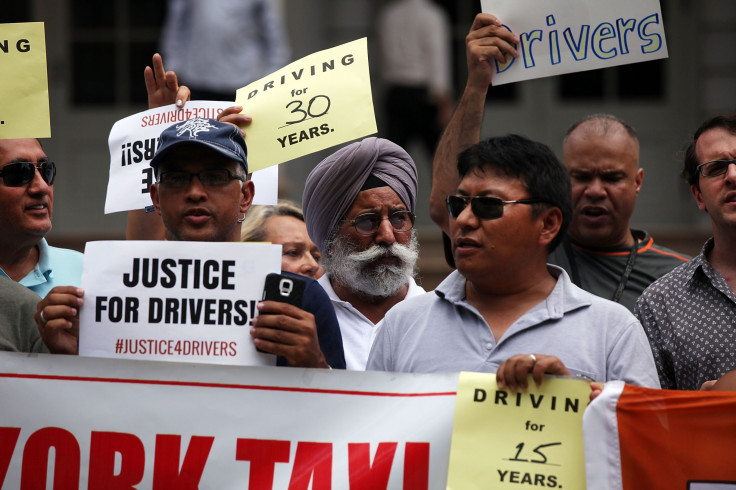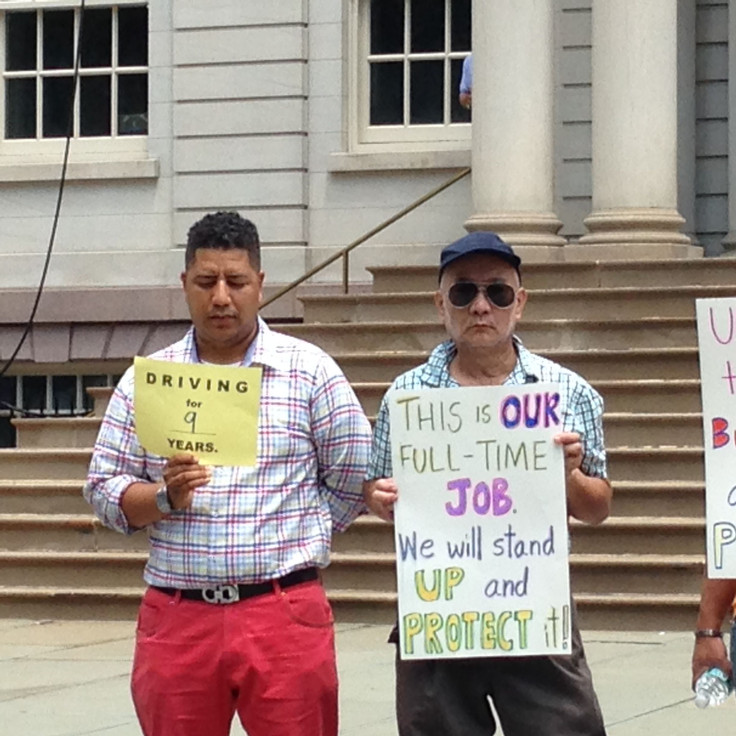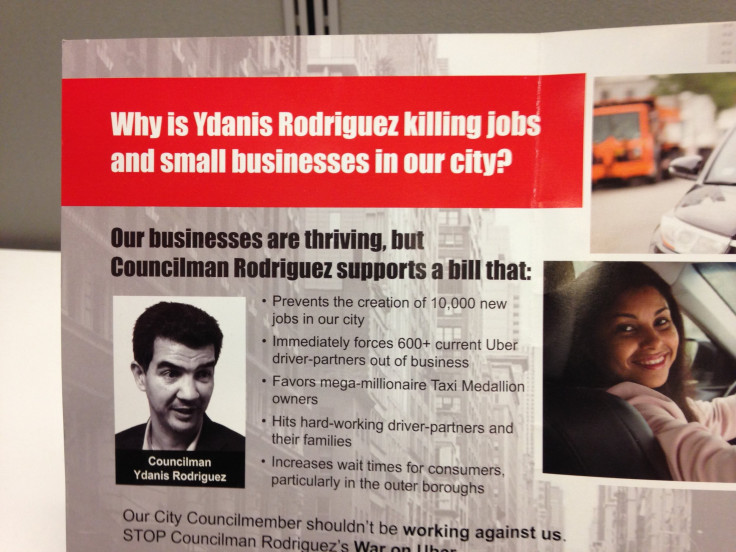Uber vs. NYC: Yellow Cab War Heats Up As Officials Debate De Blasio-Backed Vehicle Cap

NEW YORK — Start your engines, ladies and gentlemen. The “Car Wars” are coming to a head here, and the angry crowd of taxi workers and labor advocates that gathered on the steps of City Hall Monday afternoon say they are outgunned in every measurable sense.
As Uber Technologies Inc. fights to prevent legislation that would restrict its unfettered growth in the U.S.' largest city, the taxi-hailing giant has been pouring enormous resources into a fierce political-style campaign, targeting voters with direct mailings and TV advertisements that characterize local politicians as out-of-touch job-killers, hurting innovation and opportunities for residents of New York’s underserved outer boroughs.
But on Monday, anti-Uber demonstrators braved the sweltering summer heat to fight back with an impassioned rally in which they painted Uber as an unwanted Silicon Valley outsider attempting to undermine the local political process with a racially charged “smear campaign.” The protesters, armed with homemade signs and banners, led chants and cheers and at one point spontaneously broke out in song, riffing on the lyrics from Pink Floyd’s “Another Brick in the Wall.”
“Hey, Uber, leave New York alone!” they sung.
Many attendees were longtime New York drivers who held small signs displaying how many years they’ve been driving professionally. Some said they were afraid Uber, whose “driver-partners” are not considered employees, would set back their working conditions decades.
Louis Lirano, 36, who lives in the Bronx, drives one of the green borough taxis the city rolled out in 2011, which are only allowed to pick up street hails in the outer boroughs and upper Manhattan. He said he came to the rally because he doesn’t think it’s fair that green cabs are restricted while Uber drivers are allowed to pick up fares wherever they please.
“I don’t like it,” said Lirano, who is originally from the Dominican Republic. “Why is Uber running the whole city?”

Hell On Wheels
Of course, Uber is no stranger to resistance from the transportation establishment in the cities where it operates, but the stakes are particularly high in New York. At issue is a proposal that would place a temporary cap on the number of for-hire vehicles in the city. Supporters of the plan say Uber and services like it have led to an explosion of traffic, adding about 25,000 new for-hire vehicles to city streets since 2011 and slowing traffic to a crawl in Manhattan’s most congested neighborhoods.
“Congestion affects everybody who needs to move around in the great city of New York,” said Bhairavi Desai, executive director of the New York Taxi Workers Alliance, who led Monday’s rally.
The City Council is set to vote on the proposal Thursday. If passed, it would prevent Uber from adding new vehicles while city officials study traffic patterns, assess the causes of congestion and seek solutions. Uber has characterized the plan as a smokescreen to protect powerful taxi interests, which gave generously to the 2013 mayoral campaign of Bill de Blasio, who supports the cap. Uber said the cap will immediately force more than 600 current Uber drivers out of business and prevent thousands more from seeking new opportunities.
Lyft, Uber’s largest rival, is also against the proposed cap. “New York is on the verge of taking a big step backwards,” said David Mack, Lyft’s director of public affairs.
Over the last two years, Uber has spent more than $225,000 lobbying the Mayor’s Office and other city officials, as the New York Times reported. That doesn’t count the recent ad blitz in which the company peppered local media outlets with commercials featuring its driver-partners touting the many benefits they say Uber brings to the city.
The company has also unleashed a direct-mail campaign on city voters in certain districts. One flyer targets Ydanis Rodriguez, a councilman who represents the city’s predominantly Hispanic District 10. Rodriguez, who once worked as a livery driver himself, chairs the Committee on Transportation and is a vocal Uber critic. In the flyer, modeled after political-style attack ads and featuring photos of Hispanic and black drivers, Uber asks why Rodriquez is “killing jobs and small businesses in our city?”
Uber’s opponents have characterized the tactic as a “race strategy.” At Monday’s rally, Rodriquez spoke to the crowd about the need to rein Uber in. He compared the company, which has been valued at $40 billion, to Walmart.

Goliath vs. Goliath
Reached for further comment Monday, an Uber spokesperson forwarded International Business Times a letter sent to de Blasio from Uber’s general manager of New York, Josh Mohrer. In the letter, Mohrer challenged de Blasio to a duel of sorts, asking that he face off against the company and address his concerns in a live-streamed conversation.
“Whether it’s improving accessibility, supporting mass transit or increasing transparency, we are eager to further discuss how we can collaborate,” Mohrer wrote. “All we ask is you put aside your current proposal to cap Uber, an idea first proposed by the taxi industry months ago, which has been roundly acknowledged to not address its purported goal.”
De Blasio declined the offer, having already stated his case in an op-ed Saturday in the New York Daily News, where he said more than 2,000 for-hire vehicles are being added to city streets every month. In pitching the cap, he said services like Uber can be a “very positive thing,” but he also expressed concern about their rapid, unprecedented growth.
But few in the local media seem to by buying it. The editorial boards of the New York Times and the Daily News both publicly denounced the cap, as did editorial writer Robert George of the New York Post, who called New York’s yellow-cab service a “decades-long government-approved monopoly operating a system that discriminates against” communities of color, often by refusing to drive to them. “Uber, Lyft et al would pick us up and take us home -- regardless of our addresses,” George wrote.
Back on the steps of City Hall, Desai disagreed. She said even as Uber has been touting the opportunities it provides for its driver-partners, the long-term outlook for those drivers will be a lot less certain -- and a lot more automated -- should Uber be allowed to flourish unregulated.
“This is the same company that in Austin, Texas, is testing out the driverless car,” Desai said. “That’s how much they care about the drivers. They can’t wait to replace us.”
Christopher Zara is a senior writer who covers media and culture. News tips? Email me. Follow me on Twitter @christopherzara.
© Copyright IBTimes 2024. All rights reserved.





















